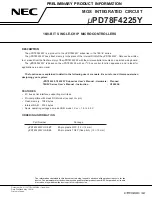Chapter 1
Introduction to the Development Kit
14
© NXP Semiconductors 2017
JN-UG-3121 v1.1
1.2.4 Network Formation and Topology
A wireless network is formed as follows:
1.
The first node to be started is the Co-ordinator, which performs network
initialisation including the selection of the radio channel in which the network
will operate (see
) and the PAN ID of the network (see
).
2.
Once the initialisation is complete, the Co-ordinator allows other nodes to join
it as its ‘children’ - the Co-ordinator is referred to as a ‘parent’. These child
nodes can be Routers and/or End Devices.
3.
Each Router may itself become a parent by allowing child nodes to join it
(which may themselves be Routers and/or End Devices). In this way, the
network grows.
A number of network shapes or topologies are possible, which are dependent on the
wireless network protocol used. These are the Star, Tree and Mesh topologies,
described in the sub-sections below.
1.2.4.1
Star Networks
A Star network contains only one routing node, which is the Co-ordinator. Thus, all
messages between the network nodes are routed via the central Co-ordinator.
Figure 3: Star Network
Co-ordinator


















